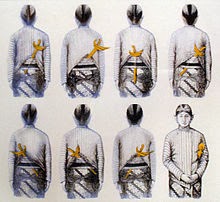"Legends tell of keris that could move of their own volition and killed individuals at will. Some keris are rumored to stand upright when their real names are called by their masters."
The kris or keris is an asymmetrical dagger indigenous to Indonesia, Malaysia, Thailand and Brunei. It is known as 'kalis' in the southern Philippines.
Keris is a weapon dagger class (and sharply pointed on both sides). The shape is distinctive and easily distinguished from other sharp weapons because it is not symmetrical at the dilated, often tortuous/wavy blade(some of them have straight blades) , and many of them have the prestige (damascene), which bright metal strokes on blade. Type of this stabbing weapon has similarities with the ‘badik’.

"The making of a keris was the specialised duty of metalworkers called empu or pandai besi......Keris-makers did more than forge the weapon, they carried out the old rituals which could infuse the blade with mystical powers."
Both a weapon and spiritual object, keris are often considered to have an essence or presence, with some blades possessing good luck and others possessing bad.
The making of a keris was the specialised duty of metalworkers called empu or pandai besi. In Bali this occupation was preserved by the Pande clan to this day, members of whom also made jewellery. Keris-makers did more than forge the weapon, they carried out the old rituals which could infuse the blade with mystical powers. For this reason, keris are considered almost alive because they may be vessels of spirits, either good or evil.
Legends tell of keris that could move of their own volition and killed individuals at will. Some keris are rumored to stand upright when their real names are called by their masters. It was said that some keris helped prevent fires, death, agricultural failure, and many other problems. Likewise, they could also bring fortune, such as bountiful harvests.
Many of these beliefs, however, were erroneously derived from the possession of different keris by different people. For example, there is a type of keris in Java that was called Beras Wutah, which was believed to grant its possessor an easy life without famine. In reality, this keris was mainly assigned to government officers that were paid, in whole or in part with foodstuff such as rice.
There are several ways of testing whether a keris is lucky or not. A series of cuts on a leaf, based on blade width and other factors, could determine if a blade was good or bad. Also, if the owner slept with the blade under their pillow, the spirit of the keris would communicate with the owner via dream.
If the owner had a bad dream, the blade was unlucky and had to be discarded, whereas if the owner had a good dream the dagger would bring good fortune. However, just because a blade was bad for one person didn't mean it would be bad for another. Harmony between the weapon and its owner was critical.
Because some keris are considered sacred and believed to possess magical powers, specific rites needed to be completed to avoid calling down evil fates which is the reason warriors often made offerings to their keris at a shrine. There is also the belief that pointing a keris at someone means they will die soon, so silat practitioners precede their demonstrations by touching the points of the blades to the ground so as to neutralise this effect.(sources: wikipedia)



No comments:
Post a Comment